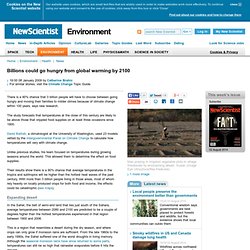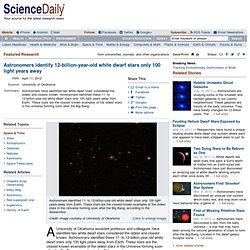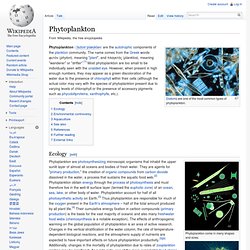

Hurricanes are getting fiercer. Cause and effect for global warming. Cause of global warming Almost 100% of the observed temperature increase over the last 50 years has been due to the increase in the atmosphere of greenhouse gas concentrations like water vapour, carbon dioxide (CO2), methane and ozone.

Greenhouse gases are those gases that contribute to the greenhouse effect (see below). Billions could go hungry from global warming by 2100 - environment - 08 January 2009. There is a 90% chance that 3 billion people will have to choose between going hungry and moving their families to milder climes because of climate change within 100 years, says new research.

The study forecasts that temperatures at the close of this century are likely to be above those that crippled food supplies on at least three occasions since 1900. David Battisti, a climatologist at the University of Washington, used 23 models vetted by the Intergovernmental Panel on Climate Change to calculate how temperatures will vary with climate change. Unlike previous studies, his team focused on temperatures during growing seasons around the world. This allowed them to determine the effect on food supplies. 20 Deadliest Effects of Global Warming. Global Warming Effects and Causes: A Top 10 List. June 7th, 2009 by Derek Markham One of the biggest issues facing us right now is global warming.

Its effects on animals and on agriculture are indeed frightening, and the effects on the human population are even scarier. The facts about global warming are often debated in politics and the media, but, unfortunately, even if we disagree about the causes, global warming effects are real, global, and measurable. The causes are mainly from us, the human race, and the effects on us will be severe. –> Highly recommended: What is Causing Global Warming? –> You may also like: Global Warming Videos (Best, Funniest, & Most Inspiring) Global Warming Effects and Causes: A Top 10 List 1. Our ever increasing addiction to electricity from coal burning power plants releases enormous amounts of carbon dioxide into the atmosphere. 40% of U.S. 2.
Our modern car culture and appetite for globally sourced goods is responsible for about 33% of emissions in the U.S. Astronomers identify 12-billion-year-old white dwarf stars only 100 light years away. A University of Oklahoma assistant professor and colleagues have identified two white dwarf stars considered the oldest and closest known.

Astronomers identified these 11- to 12-billion-year-old white dwarf stars only 100 light years away from Earth. These stars are the closest known examples of the oldest stars in the Universe forming soon after the Big Bang, according to the OU research group. Mukremin Kilic, assistant professor of physics and astronomy in the OU College of Arts and Sciences and lead author on a recently published paper, announced the discovery. Kilic says, "A white dwarf is like a hot stove; once the stove is off, it cools slowly over time.
By measuring how cool the stove is, we can tell how long it has been off. Phytoplankton. Diatoms are one of the most common types of phytoplankton.

Phytoplankton /ˌfaɪtoʊˈplæŋktən/ are the autotrophic components of the plankton community. The name comes from the Greek words φυτόν (phyton), meaning "plant", and πλαγκτός (planktos), meaning "wanderer" or "drifter".[1] Most phytoplankton are too small to be individually seen with the unaided eye. However, when present in high enough numbers, they may appear as a green discoloration of the water due to the presence of chlorophyll within their cells (although the actual color may vary with the species of phytoplankton present due to varying levels of chlorophyll or the presence of accessory pigments such as phycobiliproteins, xanthophylls, etc.).
Ecology[edit] Phytoplankton come in many shapes and sizes. By 2050 Warming to Doom Million Species, Study Says. John Roachfor National Geographic News Updated July 12, 2004 By 2050, rising temperatures exacerbated by human-induced belches of carbon dioxide and other greenhouse gases could send more than a million of Earth's land-dwelling plants and animals down the road to extinction, according to a recent study.

"Climate change now represents at least as great a threat to the number of species surviving on Earth as habitat-destruction and modification," said Chris Thomas, a conservation biologist at the University of Leeds in the United Kingdom. Untitled. Henry Ford Community College - Associate Degrees, Continuing Education.
The Top 5 "Positive" Effects of Global Warming. 5.

Booming businesses… in the Arctic. The world economy needs a shot in the arm. I know the feds just cut interest rates by .75, but that’s nothing compared to what a melted Arctic Circle could do. Without all that pesky ice in the way, the Arctic Ocean would be completely open, creating a brand new trade route from the Atlantic to Asia. Global warming. Global mean land-ocean temperature change from 1880 to 2014, relative to the 1951–1980 mean.

Midwest Impacts & Adaptation. Key Points The Midwest will likely experience hotter summers with longer dry periods and milder, wetter winters.

In Midwest urban areas, climate change will likely make it more difficult to maintain current summer air quality. Climate change will likely place additional stress on infrastructure and the economy, particularly on shipping routes on the Great Lakes. In the short-term, Midwest crop yields may benefit from less snow cover and a longer growing season. Related Links Other: View enlarged image Projected change in summer temperatures under different warming scenarios. John Tyndall. JOHN TYNDALL By William Reville, University College, Cork.

John Tyndall (1820-1893) was one of the greatest scientists of the 19th century. He made important contributions in physics, atmospheric science and geology. Tyndall was also a gifted public lecturer, an avid promoter of the public understanding of science, and a noted mountaineer. He is best remembered popularly as the man who first explained why the sky is blue. John Tyndall was born in Leighlinbridge, Co. John joined the Irish Ordnance Survey in 1839 as a surveyor/draughtsman and was transferred to the English Survey in 1842.
In 1848, Tyndall went to Marburg, Germany to do a Ph.D. on magnetism in the laboratory of Robert Bunsen (1811-1899).